Daiwa Saltiga Z 6000 : The Review
Hi everyone
My past experiences with Daiwa's reels were not particularly pleasant. Owned many of them over the years from the classic internal spool reels to the modern heavy duty jigging ones, and rarely did one serve me without a problem of some sort. Just recently an Emblem-XA 5000 died on me when the gears stripped, and my first Thailand made Black Gold 90 wobbled right out of box, and it was so bad I had to work on it before it could be used. Overall, and with the exception of one or two reels, I was not very content with any of my Daiwas and always preferred Penns to them.
Daiwa ventured into the world of high end saltwater spinning reels a few years ago with the introduction of Team Daiwa TDX in two speeds: RIA had low gear ratio for jigging, and HIA were high speed reels for popping. They were troublesome though and had issues with handles and drags among other things. With the massive success of Shimano's 1998 Stella (known as "F" internationally), Daiwa needed a new reel that can compete with Shimano's best effort, and that was the birth of the Saltiga. It made its debut in the beginning of 2001, initially in 4000 and 4500 sizes only, then in November 2002 their big brothers joined the lineup with the 5000, 6000, and 6000GT. The 6000 (reviewed here) is a high torque low gear ratio reel for jigging, while the 6000GT is the faster retrieve popping version with a ratio of 6.3:1 and a deeper spool. The 5000 though is a useless reel that's basically a 6000 with a lower capacity spool, and it's only $10 cheaper than the 6000. Daiwa also sells an optional 6500 spool that has a slightly higher capacity and fits the 5000/6000 reels, but for $150 apiece I'm not sure it's worth it. The 5000/6000/6000GT reels are not just larger versions of the 4000/4500, but rather have fundamental design upgrades to make them more suited for bigger fish. This will be detailed later.
A few size comparison photos with a well known reel, the Penn 9500SS Spinfisher
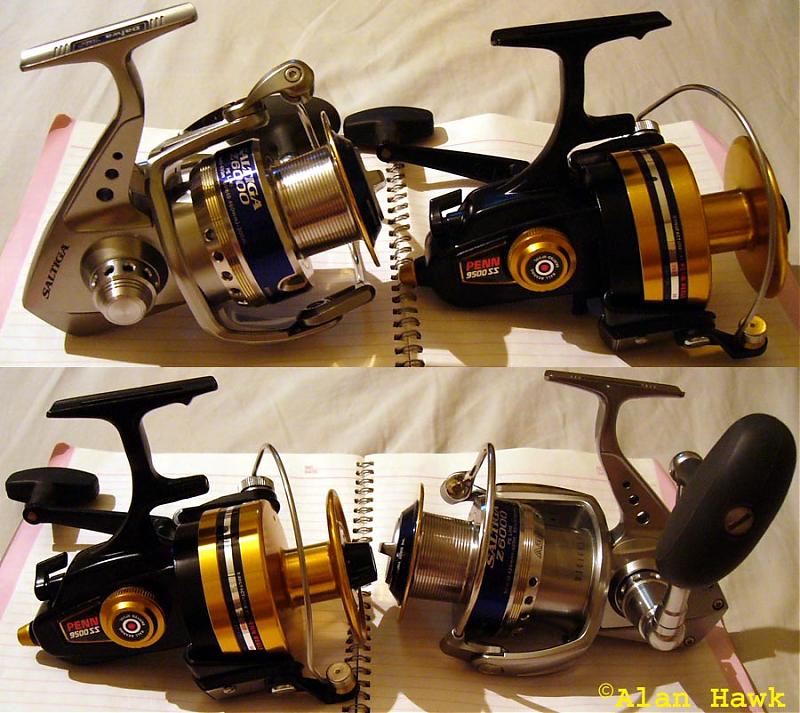 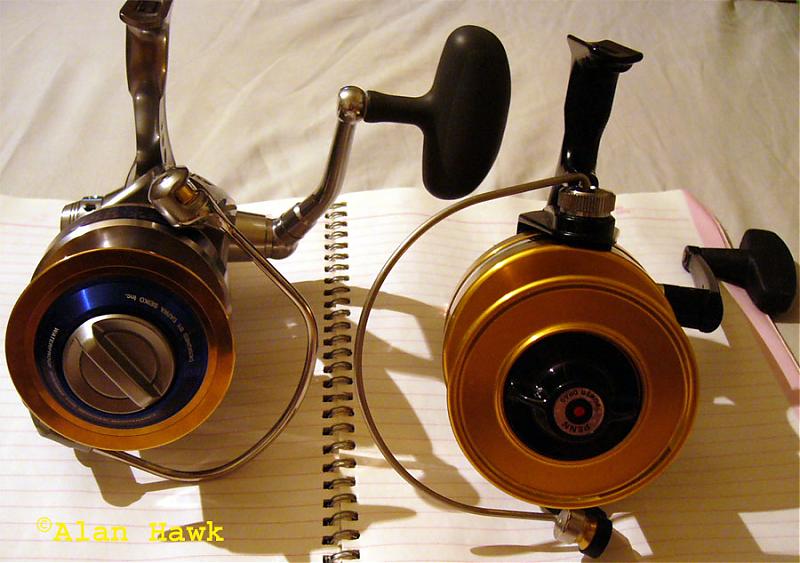 All Saltigas big and small has a full time instant anti-reverse, meaning that there isn't a switch to allow the reel to be reeled backward. I personally never reel backward and can't see myself ever needing to do that, but I know that some people need that future, so it would have been better if it was still present. Today's makers' justification for the absence of an anti-reverse switch is that this way there are less things to go wrong, but that's just rubbish. If anti-reverse switches cause problems go ahead redesign and perfect them, don't just get rid of them altogether. Anyway, the full time anti-reverse clutch in the Saltiga is a very large Japanese made NSK unit that I can't see failing or slipping.
In the same spirit of stripping the reel down off its excesses, the Saltiga doesn't have an automatic bail trip, meaning that you will have to close the bail manually after each cast. I personally never use the auto bail trip and it's just a second nature for me to close the bail manually on all reels so I have no issue with that. The reel also has a powerful rotor brake that keeps the rotor still when the bail is opened.
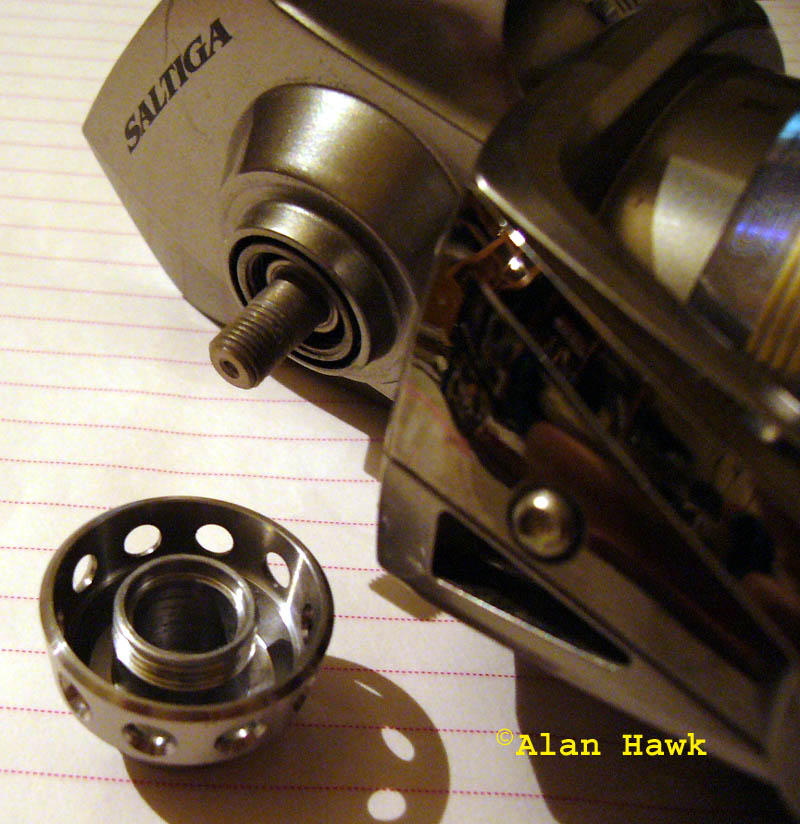 Uniquely for the Saltiga the gear axle is a threaded male shaft. In most reels the gear axle is a threaded female tube while the male shaft is in the handle. This unique feature makes the gear axle of the Saltiga thinner than regular female shafts, hence the gear could be lowered closer to the main shaft to achieve better transmission efficiency, felt as more pulling power and less effort for the angler.
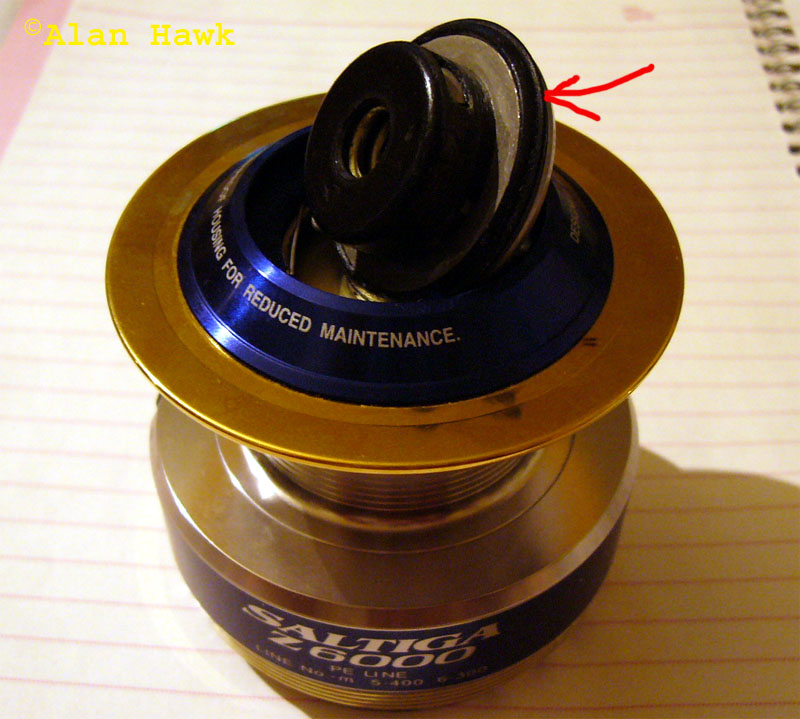 The spool has a titanium nitrated lip, and the red arrow points the rubber seal mounted on the knob.
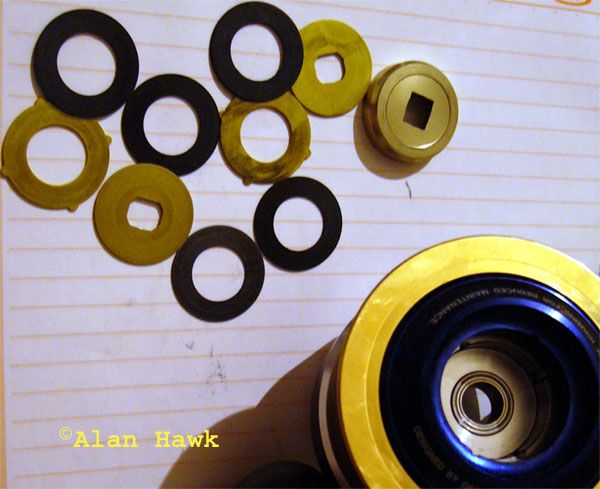 The drag of the 6000Z has five carbon friction washers that are advertised to produce 66lb (30kg) of maximum pressure. The real maximum useful drag pressure though is a little below 49lbs (22kg), as at that drag pressure the rotor arm bends so bad it actually touches the spool. The drag performance is incredibly smooth, but once you hit about 30lb (~13.5kg) the drag develops a very felt and almost disruptive starting inertia, or a "jerk" as some call it. Replacing the factory drag washers of the Saltiga Z with Carbontex drag washers is highly recommended. Still in the above photo, you can see a ball bearing inside the drag housing. The spool runs on two ball bearings.
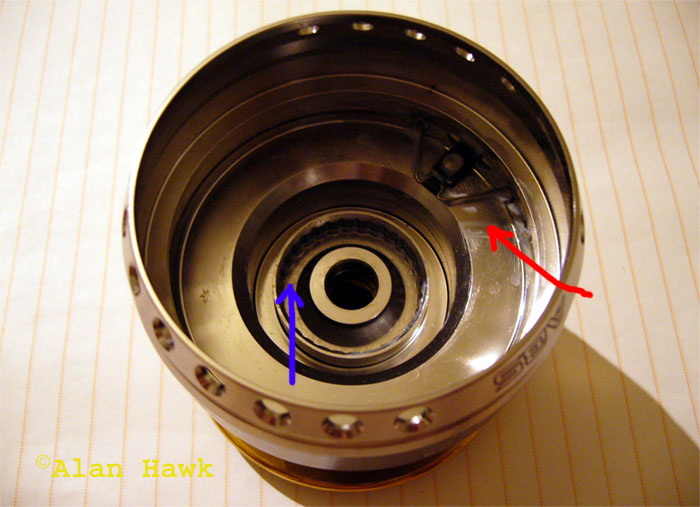 The back of the spool. The blue arrow points the teeth of the drag clicker, and the red arrow points the spring of the line clip. Line clips are traditionally bolted but here the clip is spring loaded and can move out to accommodate very thick lines.
Underneath the spool
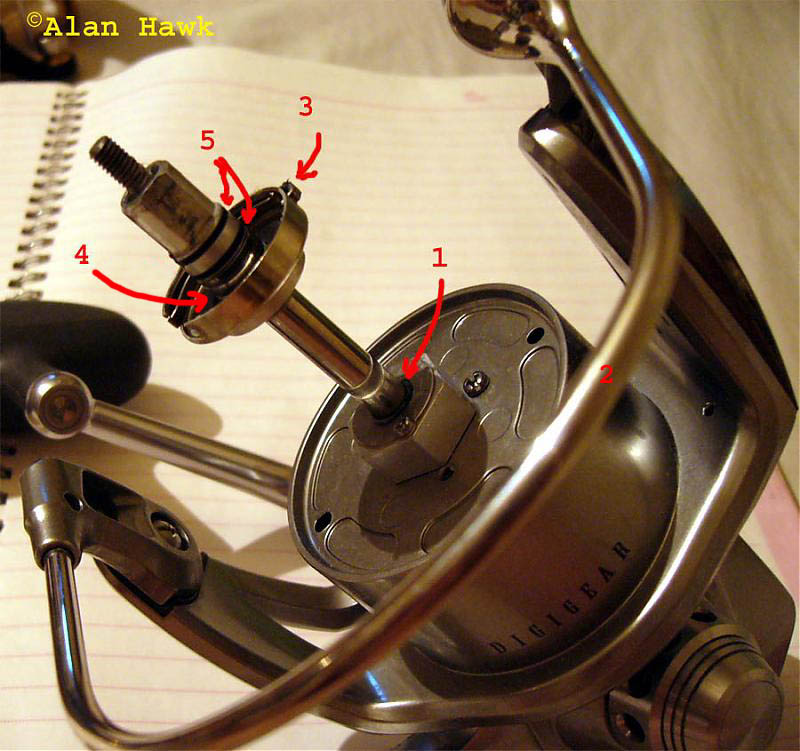 The stainless steel main shaft is of an impressive thickness, and the surrounding parts are similarly sturdy. Red arrow #1 points the main shaft's seal, #2 is the thick one piece hollow bail wire which is quite solid but once bent it can't be fixed, #3 is the drag clicker tongue, # 4 is the bottom ball bearing of the spool, and arrow #5 points the O rings forming the bottom drag sealing.
Moving into the gearbox
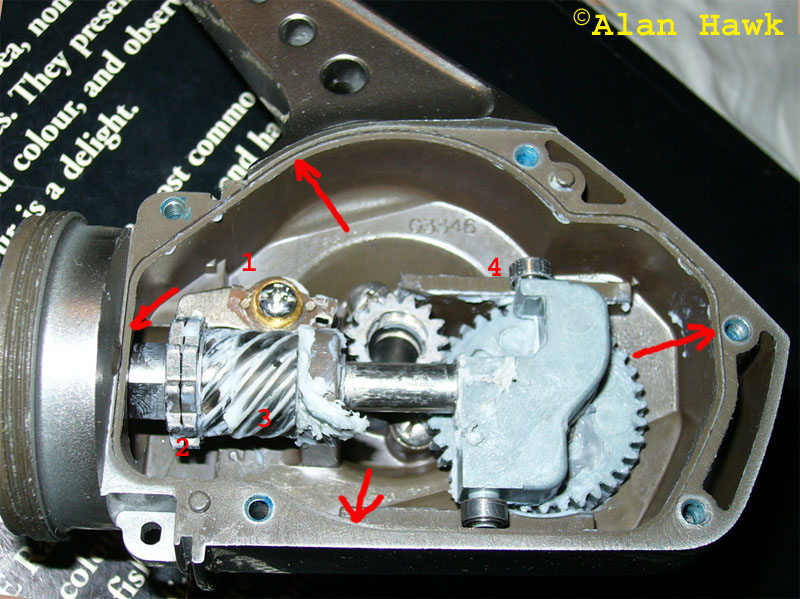 #1 in the above photo is the dog of the mechanical backup anti-reverse which comes into action if the clutch ever fails by engaging the double stainless steel ratchets (#2) to stop the rotor from spinning backwards, enabling the reel to continue catching fish until it's properly repaired. Daiwa was the pioneer of backup anti-reserve even before the Satliga. Their previous flagship reels TDX had two instant anti-reverse clutches stacked together so that if one fails the other would continue handling the job. I need to point here that the mechanical backup anti-reverse is not the same in all Saltigas. The design described here is for the 5000/6000/6000GT reels, while the smaller 4000/4500 Saltigas has a simpler design with a dog that engages a ratchet on the drive gear in case of an emergency. Obviously a dog that engages a ratchet on the pinion (Saltiga 5000/6000/6000GT) is a stronger design that's safer for the mechanism, so that's a major upgrade over the smaller 4000/4500 Saltigas.
Still in the above photo, #3 is the stainless steel pinion, and the traverse cam has two ball bearings (#4) to run on. This feature is "inspired" by the Fin-Nor Ahab reels, but Fin-Nor's version has a metal roller instead of a ball bearing. This feature works miracles when the reel is under load; in a spinning reel the power from the fish travels through the line roller to the spool which in turn twists the main shaft clockwise (if you are looking from the spool's end), and this pressure forces the traverse cam to rub hard against the reel's body causing friction and loss of energy. By putting a roller or ball bearing on the side of the traverse cam as in the Saltiga though the cam would roll on the bearing with virtually no friction or energy loss no matter how big the load is. The red arrows point the dedicated recess going around the entire gearbox, in which a seal is fitted creating a waterproof body.
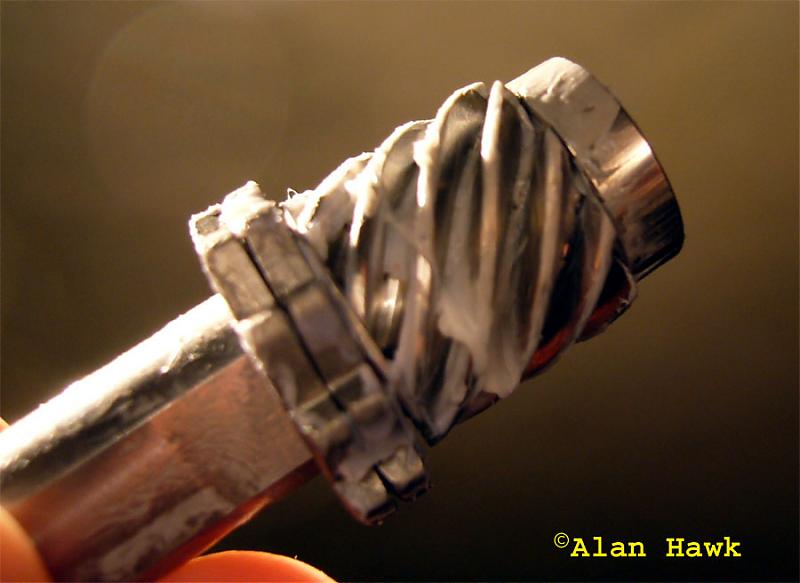 A close up on the massive stainless steel pinion with the inner ball bearing it runs on and the backup anti-reverse ratchet. I can't see this powerful pinion wearing out or breaking.
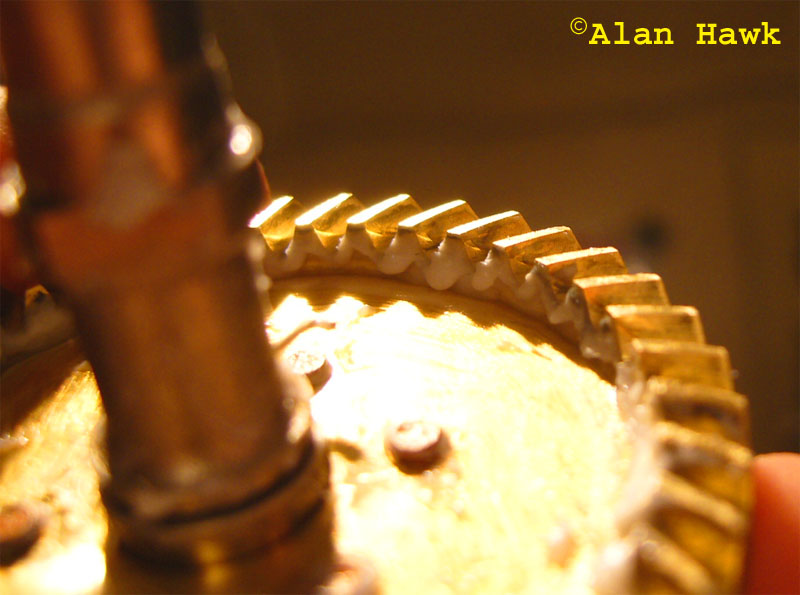 Before the Saltiga, Daiwa's top spinning reels had aluminium drive gears. For the Saltiga they went with marine bronze, which is a very tough aluminium/bronze alloy named C6191. Coupled with the stainless steel pinion, this drive train is virtually indestructible and should last for a very long time. The gears are cut in a 3D numerically controlled process creating what Daiwa calls "Digigear". This sophisticated operation creates teeth that mesh perfectly with the mating surfaces on both gears in full contact even along the curvatures. This translates into better power transmission, unprecedented smoothness, and most of all, durability that is sure to withstand abuse over many years of operations.
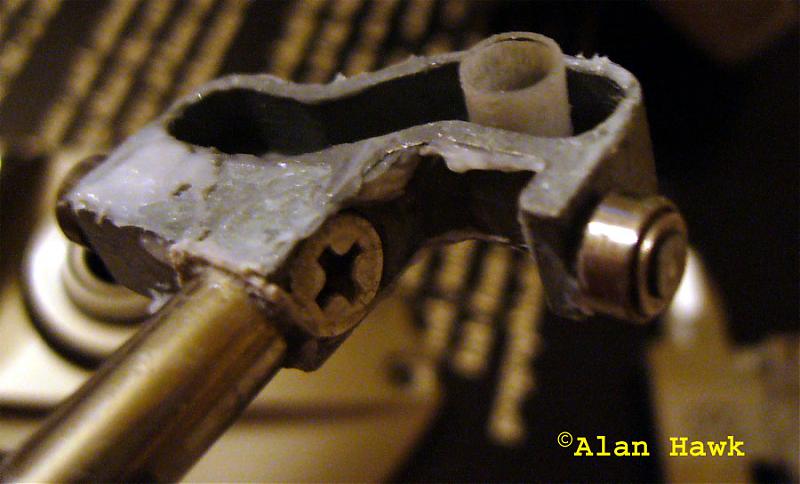 The backside of the traverse cam shows the unusually shaped oscillation channel and the synthetic bearing inside it to reduce friction. This unusual shape of the channel increases the length of the spool stroke, meaning that the spool goes up further and retracts down further as well. In other reels that have traditional straight channels the stroke length is limited to the diameter of the oscillation gear. This great feature of the Saltiga allows for a longer spool that holds more line and casts better than regular reels.
Let's take a little detour here and meet the Saltiga's bastard cousin!
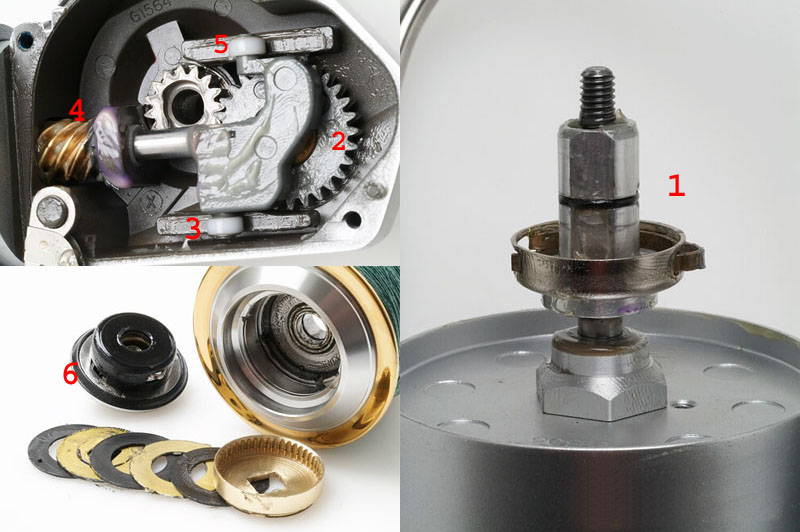 This is the "Saltiga Blast", which is a shameless attempt by Daiwa to make money on the Saltiga's name. It's a much lower quality reel that externally resembles the Saltiga and shares a few of its parts, but otherwise the Blast has an aluminium drive gear, a brass pinion (#4 in the above image), synthetic washers (#3 & #5) instead of ball bearings, the line lay gear (#2) is borne on a bushing instead of a ball bearing, and the handle is cast instead of machined. A good thing though is that while the waterproofing is gone from the gearbox, they still kept the spool waterproof with a rubber seal on the knob (#6) and an O ring on the spool hub (#1).
Back to my Saltiga Z...
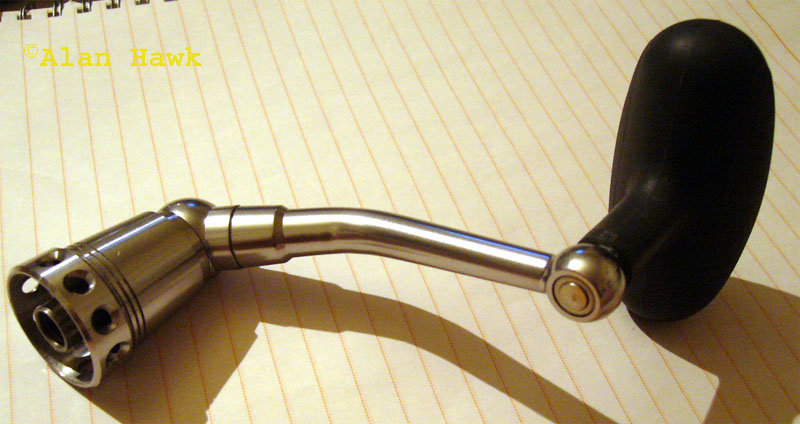 The handle is a machined aluminium. They call it "one piece handle" but in reality it isn't. Other than the knob the handle is made of three different parts that meet at the joint and held together by a hidden pin and a screw. It's a non-collapsible design that can't be folded down, but while it's not he best thing for travelling and transportation, I personally like its solid feel.
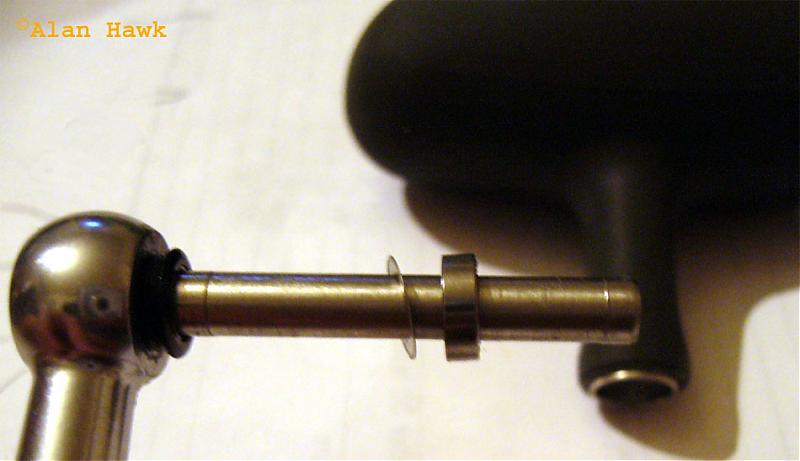 The handle knob itself runs on two ball bearings, one of which is visible in the above photo while the other is inside the opposite end of the knob. Also in the photo you can see one of the two knob seals on the left end of the stem....
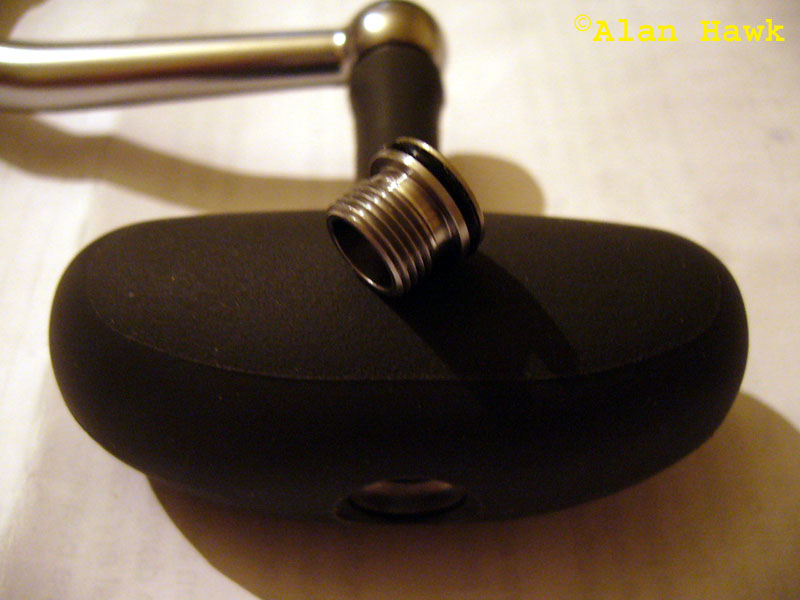 .... and here is the second one. An O ring mounted on a screw, completing the perfect sealing of the knob.
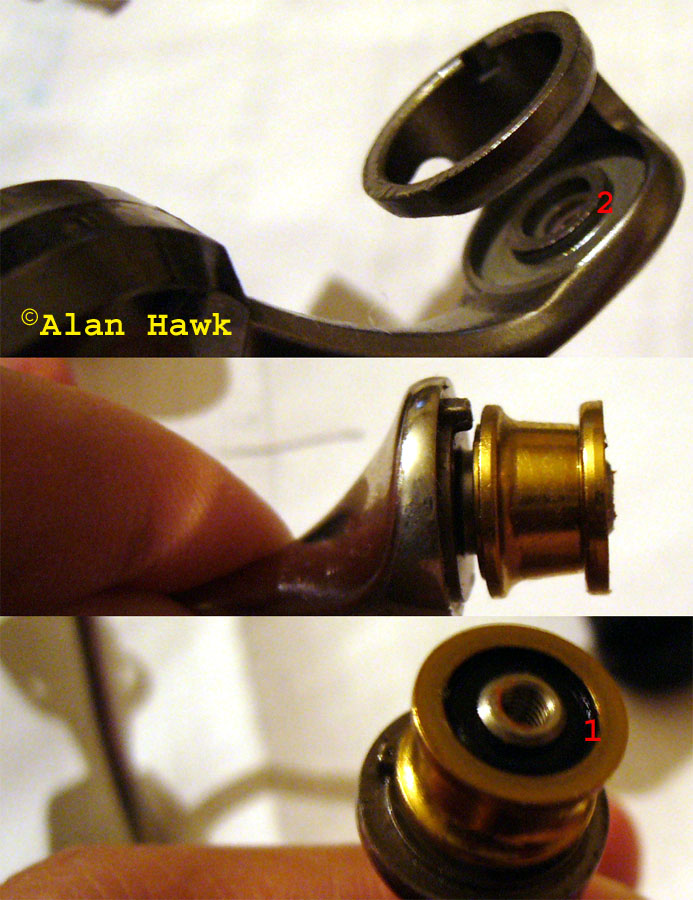 The line roller is of a big diameter and wide enough to accommodate all sorts of leader lines. It's titanium nitrated and runs on two tiny shielded ball bearings. Marked in the image above are one of the two seals of the roller (1), and a little hub (2) which keeps the seal pressed in place for maximum protection against water penetration. There is a similar seal on the other side of the roller.
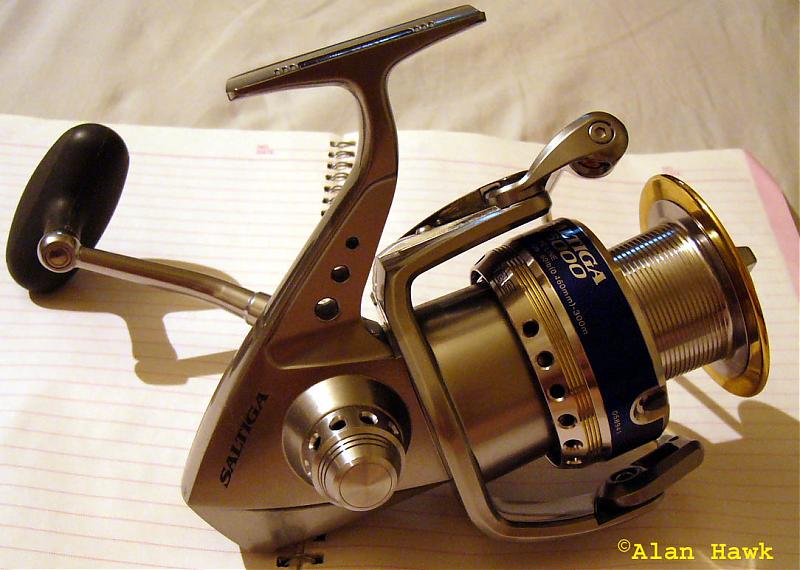 Other features of this reel are 14 ball bearings placed at friction points, and it "borrows" Shimano's "floating shaft" design which is a ball bearing strategically placed in the rotor's nut to keep the main shaft from coming in contact with the pinion. Reels with that feature are very easy to crank under load.
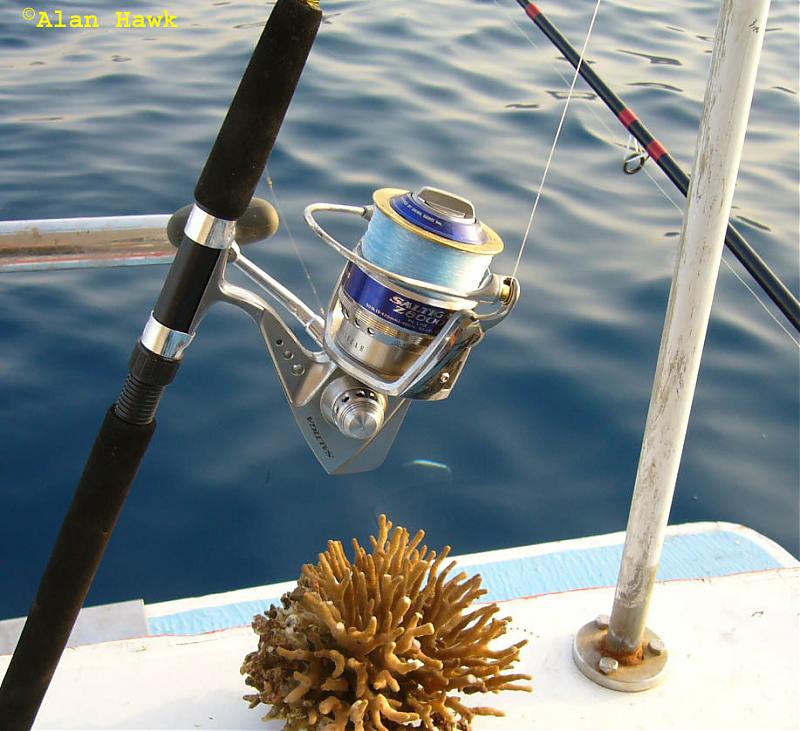 The reel following a long day of trolling, something I never thought I'd be doing with a spinning reel, but the Saltiga Z is certainly a reel that gives me much confidence.
Overall, this is a truly fine machine that is both tough yet smooth to operate because of the advanced engineering employed in it. And while the Saltigas are mainly offshore jigging/popping reels, their excellent water proofing makes them useful tools for surf fishing where you need a reel that could be dunked and reeled underwater without a problem, The price is quite high, but the materials, fit and finish, and overall quality fully justify it. After all, this reel is a member of an exclusive club of high end reels that are capable of landing truly big fish, and such distinction never comes cheap.
Hope you've enjoyed the read
 Was this a good read? Please click here
Alan Hawk
March, 25th, 2003
|